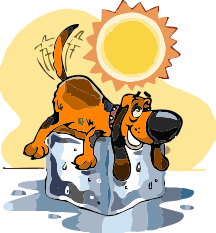
How to Beat the Heat – And Keep Your Dog(s) Safe This Summer
So far, this has been one of the hottest Summers on record. Staying cool needs to be a priority for humans and our canine family.
Tips to Keep Your Dog Safe This Summer
- Keep Your Dog Hydrated: Give your furry companion plenty of water. Notice the sign of dehydration such as excessive drooling, dry gums, etc. Keep the water bowl in a place where it is easily accessible for the dog. You may also look at adding playing in the water to your dog’s playtime. This will help lower their body temperature. Ensure that your pet has access to clean water. When going outside, carry a bottle for your dog as well as you do for yourself. Also, look at increasing their fluid intake, if possible.
-
- Other water related tips:

- Consider buying a Pet Water Fountain: Investing in a pet water fountain provides a continuous flow of fresh water for dogs. The flowing water not only encourages them to drink more but also helps keep the water clean and free from dirt and debris.
- Add Ice Cubes: During scorching weather, adding a few ice cubes to their dogs’ water bowl can help keep the water cool and refreshing. However, moderation is key, as too many ice cubes may lead to rapid drinking and potential stomach upset.
- Try Wet Food: Incorporating water into their dogs’ wet food can help keep them hydrated while providing a tasty and satisfying meal.
- Other water related tips:
- Provide Shade: Keep your pet dog in the shade as much as possible specifically when it’s hot outside. Sunbathe is good, however; direct sunlight can overheat the dog and sometimes often lead to a heart stroke. Some general symptoms of overheating are vomiting, wobbly legs, etc. Generally, dogs drink water or pant to bring down their body temperature.
- Provide Ventilation: Consider a battery powered fan if you are outside or regular fan for indoors. Many dogs love to lie in front of a fan.
- Mindful Walking/Exercise: Avoid exercising or limit exercises in summer. Keep in mind the temperature while deciding the intensity and the duration of the exercises. You may either take your pet dog for a walk either early in the morning or late in the evening. Don’t stay too far from the drinking water.
- Use Cooling Products: Consider using specially designed cooling mats or vests to regulate their dogs’ body temperature and provide relief from the heat.
- Avoid Hot Pavement: Hot pavement or sand can cause burns on dogs’ paw pads. Pet owners should always check the temperature before allowing their pets to walk on such surfaces.
- Do Not Leave Your Pet Dog Alone: If you are taking your dog outside, avoid leaving them alone in the parked vehicle. Even with the windows open, your dog can be affected by strong heat. In case you have to go out of the car, always leave the dog in the car with the AC turned on, yet, it’s not the best thing to do.
- Avoid Shaving Your Pet: It’s important to understand that the dog’s coat is naturally designed that keep it cool during the summer season and warm in the winter. You may trim the fur but never shave. Ensure to leave a complete inch of hair to secure your pet’s skin from sunburns. You should always take care of your pet dog’s regular grooming, regardless of the season.
- Keep Their Paws Cool: The pet dog heat and cools from the bottom up. Keep your pet dog off of hot surfaces like asphalt and cement. In case, they do, it can burn their paws and also increase body temperature leading to overheating.
- Apply Sunscreen: Yes, believe it or not! Dogs too get sunburn just as humans. If your dog has a short or light hair coat they are prone to having a sunburn. Ensure to apply sunscreen at the least hair-covered spots such as the nose, ears and bellies. Some sunscreens are pet friendly, you must consult a veterinarian for the same. Sunscreens will protect your dog’s skin from extreme sun damage.
- Protection from Pests: The mosquitoes and ticks are at their peak during the summer season. You may also consult a veterinary and understand the various preventatives available in the market.
Summers also call for power outages. Be prepared with a plan for your dog if in case such a situation arises. Besides, watch for signs of heart stroke like excessive panting and/or salivating, etc. Ensure to have your veterinary details handy.
